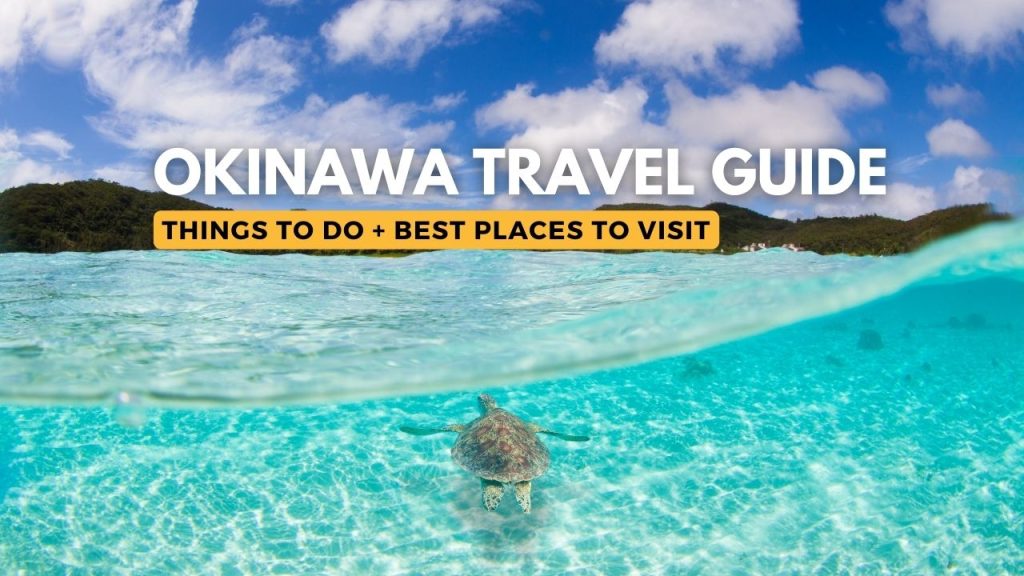OKINAWA TRAVEL GUIDE: Tourist Attractions and Places to Visit
9 min read
Okinawa Travel Guide: Top Tourist Attractions and Tips
Okinawa, the southernmost prefecture of Japan, is a breathtakingly beautiful destination known for its unspoiled beaches, rich cultural heritage, and significant historical sites. Visitors can immerse themselves in the stunning karst landscapes and lush woodlands of the Okinawa Main Island or simply unwind on the pristine white sand beaches found on the smaller islands. The prefecture offers a captivating fusion of traditional Ryukyu Kingdom customs and contemporary attractions, making it an essential stop for any traveler.
Visit Okinawa
Okinawa offers a wide range of experiences that appeal to all types of travelers. From visiting historical sites like Shurijo Castle Park to exploring colorful reefs and crystal-clear waters ideal for diving, the destination has something to satisfy every visitor. With convenient transportation options connecting major Japanese cities and various places in Asia, planning a trip to Okinawa is effortless.
Discover Okinawa at your own pace, island by island. Visit the Okinawa Main Island with its chic seafront promenades in Chatan or the secluded coves of the Yaeyama islands. Embrace the rich cultural heritage and natural beauty that make Okinawa a unique and unforgettable travel destination.
Understanding Okinawa
Okinawa stands out with its unique geographical features, historical background, and cultural richness, making it a captivating destination for travelers.
Geographical Overview
Okinawa is an island region located in the southern part of Japan. It consists of several islands, including the main island, Ishigaki, Miyako Island, the Yaeyama Islands, and the Kerama Islands. The capital city, Naha, is situated on the main island. Okinawa’s climate is subtropical, with mild winters and warm summers. Its crystal-clear waters and vibrant coral reefs make it a paradise for scuba diving and snorkeling.
Historical Significance
Okinawa has a rich history that includes the Ryukyu Kingdom period and significant events from World War II. Shuri Castle, a UNESCO World Heritage site, serves as a reminder of the Ryukyu heritage. Castle ruins and heritage sites dot the region, showcasing its past. Okinawa also hosted American troops post-World War II, which influenced its development. The blend of Japanese and American cultural elements is still evident today.
Cultural Landscape
Okinawa boasts a diverse cultural landscape. Traditional crafts like bingata, a type of textile dyeing, and music played on the sanshin (a three-stringed instrument) are integral to Okinawan culture. The region is also known as the birthplace of karate. Festivals, traditional dances, and culinary specialties like Okinawa soba also reflect its rich cultural heritage.
Exploring the area’s diverse traditions, visitors can immerse themselves in a blend of ancient and contemporary practices ranging from arts and crafts to local music.
Planning Your Trip
To enjoy Okinawa, consider when to go and how to get around. You’ll also need to think about where to stay and what to eat.
Best Time to Visit Okinawa
Okinawa has a subtropical climate with mild winters and hot summers. The best time to visit is from March to early May or from late September to early December. During these months, you can enjoy pleasant weather and fewer crowds.
Summer is peak season for beaches, scuba diving, and snorkeling due to warm sea temperatures. In winter, temperatures rarely drop below 15 degrees Celsius, making it excellent for festivals and whale watching. Avoid the rainy season in May and the typhoon season from June to September.
Getting To and Around Okinawa
Okinawa is accessible via Naha Airport, with direct flights from major cities like Tokyo, Osaka, and Kagoshima. You can also arrive by ferry, though this takes longer.
Once there, getting around includes various options:
- Plane: For travel between distant islands.
- Rental Car: Offers flexibility for exploring remote areas.
- Bicycle: Ideal for short distances and eco-friendly touring.
- Monorail: Convenient for Naha City.
For easy travel between islands, many tourists prefer ferries and domestic flights.
Accommodation and Dining
Okinawa offers diverse accommodation options from hotels to traditional ryokan. In Naha City, you can find luxury hotels and budget options.
Okinawan food is unique and delicious. Try soki soba, a popular noodle dish, and for dessert, Okinawan tart. Don’t miss the local take on Spam, often served with rice and seaweed. For a refreshing drink, sample the local awamori liquor, a staple at many restaurants and bars. Dining in Okinawa is a chance to enjoy both traditional and modern Japanese cuisine.
Key Attractions and Activities
Okinawa offers a blend of natural beauty, historical landmarks, and vibrant entertainment spots. Visitors can explore pristine beaches, ancient castles, bustling markets, and engaging museums.

Nature and Parks
Okinawa’s natural landscapes are breathtaking. Iriomote Island is a must-visit, known for its lush jungles and diverse wildlife. Kabira Bay offers stunning views and crystal-clear waters, perfect for kayaking and glass-bottom boat tours.

Yanbaru in the northern part of the main island is ideal for hiking and birdwatching. Kume Island boasts expansive white sandy beaches, particularly Hatenohama Beach, renowned for being one of the most pristine in the region.

Okinawa Churaumi Aquarium, home to various marine life forms, is famous for its massive Kuroshio Sea tank. Visitors can observe whale sharks and manta rays up close.

Cultural Treasures
Okinawa’s rich cultural heritage is showcased in its historic sites and museums. Shurijo Castle in Naha is a UNESCO World Heritage site and was the royal palace of the Ryukyu Kingdom. The renovated structure provides insight into Okinawa’s royal past.
Naminoue Shrine, perched on a cliff overlooking the ocean, is a spiritual site with stunning views. The Okinawa Prefectural Museum and Art Museum in Naha offer exhibits on local history, art, and culture.
Visitors can also explore traditional crafts and performances in village settings like Okinawa World, where ancient practices and traditional Ryukyu culture are showcased.

Entertainment and Shopping
Okinawa provides diverse options for entertainment and shopping. Kokusai-Dori in Naha City is bustling with shops, restaurants, and vibrant street performances. It’s the perfect place to buy souvenirs and taste local Okinawan cuisine.
The nightlife scene in Naha is lively, with numerous bars and clubs catering to both locals and tourists. Family-friendly attractions like the Okinawa Children’s World Zoo and Museum provide fun activities for kids.
For those interested in local crafts and unique items, Tsuboya Yachimun Street in Naha offers a variety of traditional pottery and handmade goods.
Exploring the Islands
Okinawa comprises several beautiful islands, each offering unique experiences. Highlights include cultural sites, breathtaking beaches, and captivating marine life. Let’s dive into what each island group has to offer.
Main Island Highlights
Okinawa’s main island is rich in cultural and historical sites. Visitors should start with Shurijo Castle, a UNESCO World Heritage Site that offers a glimpse into the Ryukyu Kingdom’s past. The Okinawa Churaumi Aquarium is another must-visit, famed for its massive Kuroshio Tank that houses whale sharks, manta rays, and other marine life.
The island’s beaches, like those at Cape Manzamo, provide stunning views of the coastline. For those interested in history, the Peace Memorial Park is a somber reminder of World War II, offering monuments and museums that commemorate the Battle of Okinawa.

Discovering the Yaeyama Islands
The Yaeyama Islands, situated to the south, are known for their natural beauty and vibrant marine life. Ishigaki Island is the most developed in the group and is popular for diving. Dive sites like Manta Scramble allow visitors to see giant manta rays up close.
Another gem is Kabira Bay, where you can take glass-bottom boat tours to view colorful coral reefs and tropical fish. Taketomi Island is known for its traditional Ryukyu architecture and sandy roads. Renting a bicycle is a great way to explore its serene beaches and quaint villages.

The Charm of the Miyako Islands
The Miyako Islands feature pristine beaches, clear waters, and excellent diving spots. Miyako Island itself is a haven for beach lovers. Maehama Beach and Sunayama Beach are renowned for their white sands and turquoise waters.
The island also offers unique attractions like the Miyakojima City Tropical Plant Garden, showcasing exotic plants. For adventure seekers, the underwater caves at Yabiji and diving sites provide an unforgettable experience.
Cycling is popular here, with several scenic routes offering breathtaking views of the coastline and surrounding islands. This makes it easy to explore at your own pace and discover hidden gems.
Enjoy these highlights to make the most of your Okinawa visit!

Frequently Asked Questions
What are the top attractions to visit in Okinawa?
Okinawa boasts numerous attractions that cater to a variety of interests. A must-visit is the Okinawa Churaumi Aquarium, renowned for its massive Kuroshio Tank, which houses whale sharks and manta rays. History enthusiasts will appreciate Shuri Castle, a UNESCO World Heritage site that offers a glimpse into the Ryukyu Kingdom’s past. For outdoor lovers, the Southeast Botanical Gardens provide a lush, tropical escape. Additionally, Okinawa World showcases traditional Okinawan culture and features the impressive Gyokusendo Cave. Lastly, don’t miss the vibrant Kokusai Dori Street, perfect for shopping, dining, and experiencing local nightlife.
When is the peak season to travel to Okinawa?
The peak season to travel to Okinawa is during the summer months, particularly from July to August. This period sees the highest influx of tourists due to school holidays and the generally favorable weather, despite it being part of the typhoon season. The rainy season typically ends by July, making it a popular time for beach activities and festivals. Additionally, Golden Week, which occurs in late April to early May, is another peak travel time due to the series of national holidays in Japan.
What unique cultural experiences can Okinawa offer?
Okinawa offers a range of unique cultural experiences that highlight its distinct heritage. Visitors can engage in traditional craft activities such as weaving and pottery, or learn to play the sanshin, a three-stringed instrument central to Okinawan music. Participating in traditional dance and music performances, such as Eisa dance, provides insight into the island’s rich cultural tapestry. Additionally, visitors can explore historical sites like Shuri Castle and participate in cultural festivals such as the Naha Hari, a dragon boat race, and the Shuri Castle Festival, which celebrates Okinawan history and traditions.
What is the recommended duration for a trip to Okinawa?
The recommended duration for a trip to Okinawa generally ranges from 3 to 7 days, depending on your interests and how much of the island you wish to explore. A 3-day itinerary can cover major attractions such as the Okinawa Churaumi Aquarium, Shuri Castle, and a few beaches. For a more comprehensive experience, including visits to outer islands, cultural sites, and additional leisure activities, a 7-day stay would be ideal. This allows ample time to enjoy the natural beauty, historical landmarks, and unique cultural experiences Okinawa has to offer.
How do visitors typically reach Okinawa from mainland Japan?
Visitors typically reach Okinawa from mainland Japan by flying, as it is the most convenient and fastest option. Major airlines offer regular flights from cities like Tokyo, Osaka, and Fukuoka to Naha Airport, Okinawa’s main airport. The flight from Tokyo to Okinawa takes about 2.5 to 3 hours. Another option is traveling by ferry, although this is less common due to the significantly longer travel time, which can take over a day from ports like Kagoshima.
What are some must-try foods when visiting Okinawa?
When visiting Okinawa, there are several must-try foods that showcase the island’s unique culinary heritage. Okinawa Soba, a noodle soup made with thick wheat noodles and typically topped with pork, fish cake, and green onions, is a local favorite. Goya Chanpuru, a stir-fry dish featuring bitter melon, tofu, pork, and eggs, is another iconic dish that reflects Okinawan home cooking. Rafute, which is Okinawan-style braised pork belly, offers a rich and savory taste. Additionally, Taco Rice, a fusion of American and Okinawan cuisine, combines taco-flavored ground beef served over rice with lettuce, cheese, and tomatoes. For dessert, try Sata Andagi, a deep-fried doughnut-like pastry that’s crispy on the outside and soft on the inside.
Okinawa Travel and Tour Packages
Like, Follow, and Subscribe to OutofTownBlog.com on Facebook, Twitter, Instagram, and Team out Of Town on YouTube for more Okinawa Tourist Spots.
Read:





